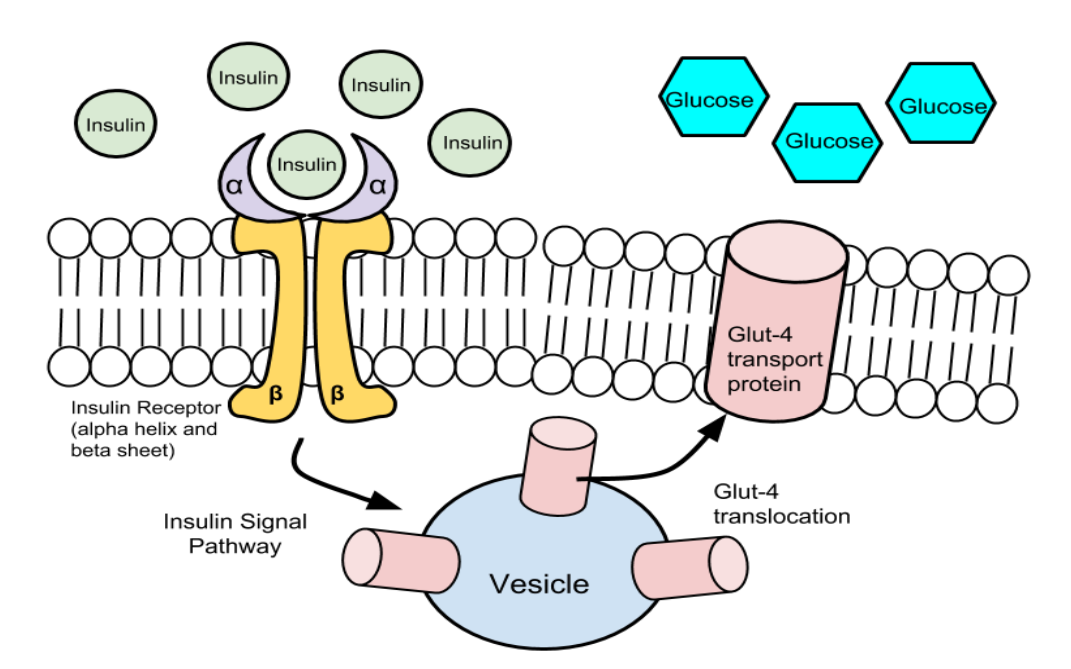Cell Signaling: How Is Glucose Taken Up by Cells?
( \newcommand{\kernel}{\mathrm{null}\,}\)
When we eat sugary foods, and carbohydrates, those disaccharides and polysaccharides are broken down into glucose. When glucose in the blood binds to glucose receptor, a signal cascade is initiated inside the pancreas that results in insulin being released into the bloodstream. The hormone then circulates in the blood and eventually binds to insulin receptors on other cells.
This glycoprotein receptor is embedded in the cellular membrane and has an extracellular receptor domain, made up of two α-subunits, and an intracellular catalytic domain, made up of two β-subunits. The α-subunits act as insulin receptors and the insulin molecule acts as a ligand. Once insulin binds to the receptor, phosphorylation takes place and initiates the signal transduction process in the cell.
Within the cell, vesicles store a transmembrane protein called GLUT-4. At the end of the signal cascade, it is incorporated into the plasma membrane of the cell. The GLUT-4 transporter then provides a channel for glucose to enter the cell where it can be used in glycolysis and cellular respiration. Any leftover glucose is packaged into glycogen and stored in the liver or it is converted to fatty acids and stored as fat in tissues.

For each of the following conditions, indicate if blood glucose levels will INCREASE or DECREASE.
___ 1. No insulin was produced by the pancreas.
___ 2. Glut-4 protein does not reach the cell membrane.
___ 3. Insulin is being overproduced by the pancreas.
___ 4. An antagonist molecule binds to the α-subunits and blocks binding by insulin.
___ 5. Mitochondria doesn’t produce enough ATP.
___ 6. Alpha helix and beta sheet proteins have been denatured.
___ 7. Glut-4 transport protein has been denatured.
___ 8. Number of Glut-4 transport proteins increased.
Type 1 Diabetes occurs when the body’s immune system attacks beta cells in the pancreas. These are the cells that are responsible for producing insulin. Those with Type 1 Diabetes take injections of insulin as a treatment for this disease. Without these injections, the cells cannot bring in glucose. Glucose continues to build up in the bloodstream because it is not being absorbed. Some of the early symptoms of diabetes are increased thirst and urination as the kidneys try to clear the excess sugar from the body. Sugar in the urine is a classic symptom of the disease, and doctors would historically taste urine as a diagnostic tool. Unfortunately, until insulin was discovered in 1921, there was no way to treat children for diabetes, and they usually died.
Type 2 Diabetes occurs when cell receptors become resistant to insulin. The cell signal is not getting through to the target cell. In response, the pancreas makes more insulin, but in some cases, it is still not enough to absorb glucose from the blood. Obesity is linked to insulin resistance, and many patients with type 2 diabetes can be treated with diet change and with additional insulin. There are also genetic factors involved with the development of type 2 diabetes.
In both types of diabetes, elevated levels of glucose in the blood can lead to long term complications, like diabetic neuropathy. This condition occurs when nerve cells become damaged which can result in numbness in extremities, slow wound healing, and even blindness.
11. Based on your knowledge of biology. What is the immediate effect for a cell that cannot obtain glucose? Use specific terms you have learned in constructing your answer.
12. Why does increasing the amount of insulin improve uptake of glucose for someone with Type 2 Diabetes?
13. Connect the endocrine system to the nervous system by explaining the relationship between glucose and neuropathy.


